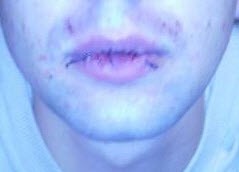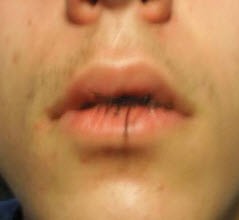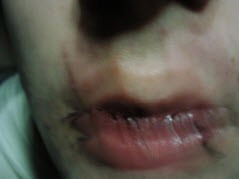Yesterday three asylum seekers at Melbourne Immigration Transit Accommodation (MITA) in Broadmeadows sewed their lips together and posted the photos on Facebook in a protest at their continued detention.
A spokesperson for the Department of Immigration and Citizenship confirmed reports of the protest, saying that the three asylum seekers engaged in self-harm over the weekend but have now “ceased their action”.
“It would be inappropriate to go into details of the self-harm, however the injuries were minor,” added the spokesperson. “All detainees received appropriate medical attention following these incidents and have access to psychological support from the detention service provider.”
The spokesperson could not confirm the time of the protest or rumours that the asylum seekers had locked themselves in their room for many hours. The spokesperson also refused to speculate on the reason for the protest.
The album of eight photos was posted on the Facebook page of one of the detainees after noon yesterday. Crikey has confirmed the names of two of the asylum seekers but these will be withheld for privacy reasons.
Below are cropped images of the photos on Facebook showing asylum seekers with their lips sewn together.



After the photos were posted, several refugee advocates responded. One asked if the asylum seekers wanted the pictures sent to the television media. At about 11.30 last night the asylum seeker responded “yes”.
Another person asked if the boys had seen a doctor yet and pleaded with them not to hurt themselves any more.
Crikey sent a Facebook message to the asylum seeker asking for a written statement about why he chose to sew his lips together. No response was provided.
Daniella Olea, from Refugee Action Collective, attempted to visit the boys yesterday but was not allowed access. When asked why the boys had sewn their lips together, she responded: “They have done that as form of protest at their desperation at being locked up for a long period of time.”
She said she also became aware of the situation through Facebook. “There are four computers at MITA so they have access to the internet. That’s their form of communication — Facebook mainly.”







And the barbarians at the gates love it. This fucking country is insane as we torture and abuse innocent people and these guys are children in Bowen’s care.
Just the citizens Australia needs. Give ’em visas immediately.
and “the injuries were minor”?
DIAC, public servants, please stop trivialising the serious action of disturbed inmates of the toxic detention system you manage for a Government that has forgotten the UN Refugees Convention which “celebrates” it’s sixtyth year this week .Meanwhile “don’t care Australia” signs away the rights of asylum seekers in a bilateral agreement with Malaysia which regularly returns them to danger and mistreats the 93 000 stuck there in slavery and disadvantage.
The action of these boys IS related to the causes, and I think prof Patrick McGorry would diagnose significant stress, anxiety and depression ,if not worse, which comes from the regime of indefinite detention (DEPRIVATION OF LIBERTY) of children who have sought our protection from persecution, but had no alternative to coming by boat because their was no orderly, safe, “proper” way to do so under threat.
How long have these boys, Wards of the Minister for Immigration been treated as (juvenile) criminals and robbed of their liberty and their youth by our sadistic Government?
Neither Cadel’s courage and magnificent achievement offshore nor the Norwegian massacre of the innocents, will divert some thinking and informed Australians from bewailing and mourning this avoidable tragedy at home.
Will Serco now take away access to Facebook?
Will that be at the request of the DIAC ?
or of the Minister?
And now they boast that they are giving $8 per starving African in aid while paying $500,000 per refugee to jail them.